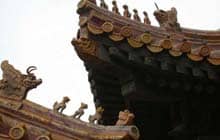Beijing or Northern Capital was made capital of the world's largest ever, land-based empire by the Mongol conqueror, Kublai Khan, in 1271. What was then the quiet market town of Yanjing was promptly remodelled into a glorious city befitting the attention and tributes of the world.
After the Mongols were overthrown in the coup of 1368, however, the first Ming Emperor Hongwu (r. 1368-1398) relocated the capital elsewhere. His descendant, unnerved by the continuing threat of the Mongols to the North, » Read more »
» Read more »
China News
Contents
Travel Snippets
Hotel/Restaurant Update For Hong Kong, Shanghai & Beijing
Imperial Tours News Blast
Odds N Ends – Interview With Last Emperor's Brother
Discovery – Chinese Museology's Brave New World
Dear Guy,
In this issue you will learn:
What Pu Ren, » Read more »
» Read more »By Guy Rubin
Centuries ago, in a cliff-face in the midst of China's vast Taklamakan desert, artists hollowed, sculpted and painted 492 caves, creating over 450,000 square feet of spectacular murals, or more than thirty times the mural area of the Sistine Chapel. But whereas the Sistine Chapel was painted over a few years, the works at the Mogao Caves began in the fourth century and were completed over the next millennium. » Read more »
» Read more »A Review of "Genghis Khan" by James Chambers
Reviewed by Guy Rubin
"Seven hundred years ago a man almost conquered the earth. He made himself master of half the known world, and inspired mankind with a fear that lasted for generations. In the course of his life he was given many names – Mighty Manslayer, Scourge of God, Perfect Warrior. He is better known to us as Genghis Khan." » Read more »
» Read more »

